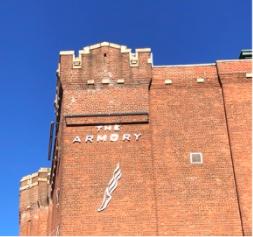
It's a good thing that our beloved director of medicine, Dr. Chuck Dinerstein (apparently), hasn't yet grown weary of the countless Zoom conferences where I inform him, "you look like a bomb blew up in your hair." Because the good doctor gave me a big heads up a couple of days ago that Weill Cornell Medical Center (1) had COVID vaccines on hand at the newly opened vaccination center in the Fort Hamilton Armory. Much to my surprise, the website worked perfectly, and there were about 20 appointments up for grabs. I grabbed.
But could this really work out? After all, the rollout of the two approved vaccines, which ACSH advisor Dr. Jeffrey Singer and I recently likened to a Keystone Kops movie in our recent op-ed in the New York Daily News, has hardly been exemplary.
Damn, was I wrong. It could have hardly gone better, something I should have figured out at the beginning when an extraordinary event occurred...
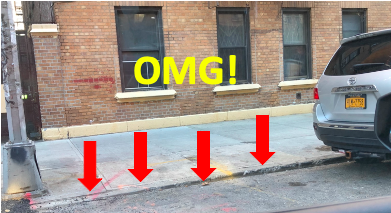
A miracle: A parking space in Manhattan?? When is the last time that happened?
I don't really remember. So, I asked around. With little success.
...
Indeed, things went spectacularly well, thanks to the extraordinary effort and superb organization by Cornell Weill Medical Center staff. The following photos will give you some idea of how (and how well) it worked.
The Entry
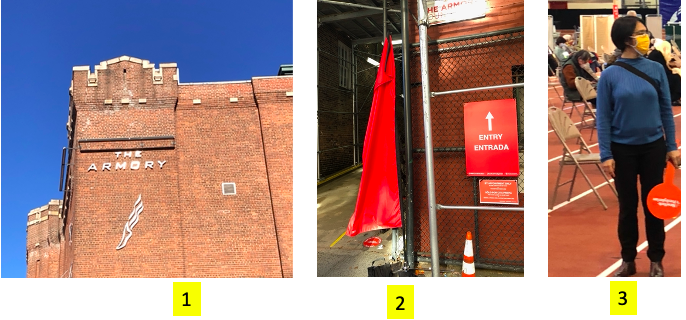
#1. The armory (duh) #2. Hard to miss the entrance. #3. There were people with red signs to keep you moving in the right direction. There were so many of them that they were about 10 feet apart during some stretches. The ~75% of them, who didn't really seem to be necessary, demonstrated their ability to multitask by also saying "hi" to everyone. Envision an armory filled with sign-holding unemployed Rockettes.
The Inoculation
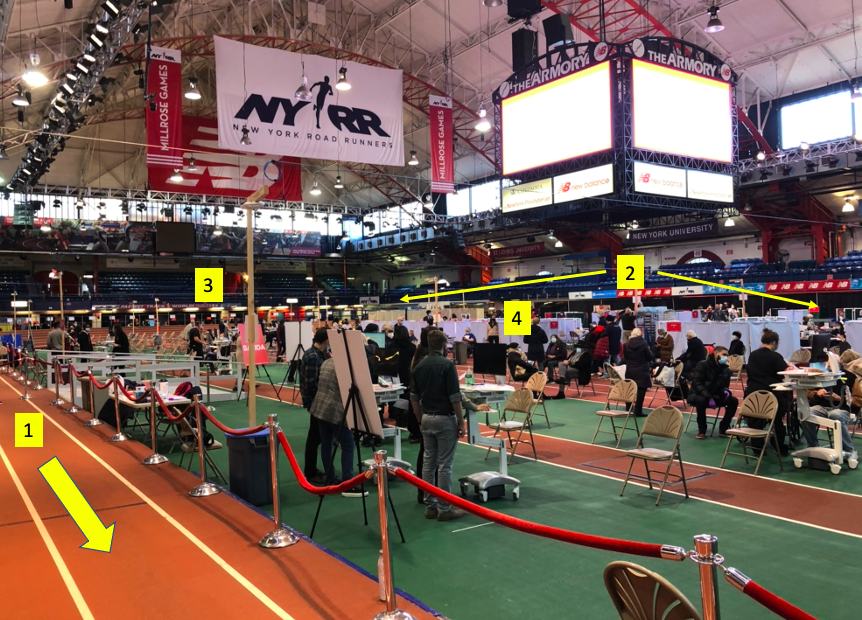
Once in the building, much of your activity consists of sprinting around a running track (it really is) and stopping at various stations, where necessary functions are carried out. From the location at #1 you are herded into the main arena. The red sign people, seemingly hundreds of them, (cropped out of the photo, to the left) are waving away like mad while performing a snappy medley of "hi" and "how are you?" They steer you to the left where you must dodge another mass of eager greeters, not unlike a running back avoiding tacklers. This takes you to #2 - a long straightaway (behind the curtains) where your job is to pick up a pencil while running as if being chased by the Army of the Dead. At #3, it's time to register for the shot (now you know what the pencil was for). This was supernaturally efficient. We were hustled to one of many empty seats (wait time = 0) at a very long table. It was here that something extraordinary happened. Before I sat down, a seat sprayer appeared from nowhere and went to work on the chair, fervently spraying and wiping both the seat and the back of the chair! While nice little touches like this serve to enhance the experience in a first-rate facility, scientifically, I just don't get it.
If you're really, really terrified of COVID and also an Olympic-class germaphobe, I can maybe see cleaning the seat, even though there have been no reports of transmission of the virus caused by chair ass juice penetrating Levi's. But the back of the chair? He's got your back for sure
Let's take a Break for "New York Irony Time!"
Since the armory is in upper Manhattan, about as accessible as Northern Greenland, it is reasonable to assume that many of the participants arrived by public transportation, probably the subway. If anything on Earth should be sprayed down, it's a subway seat.
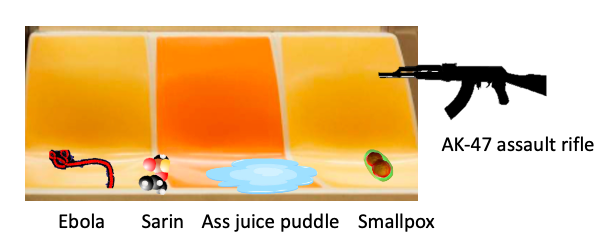
Typical New York subway seat
Time for the Shot
Having survived the registration, I was hustled over to the vaccination area (#4) to a station where a lovely Weill Cornell nurse was waiting for me (wait time = 0) with a pre-loaded syringe of the Pfizer/BioNtech vaccine! Whooo hoo! Since I'm right-handed, I chose my left arm. Five seconds later, it was done. Didn't even feel the injection. But once the Band-Aid came out, there was a standoff.
Since some of my DNA codons have apparently not evolved past the Pliocene Epoch, my arms are rather hairy, not unlike salamis with a bunch of Afro wigs Crazy Glued to them. Since I didn't want an arm wax when it was time to remove the bandage I politely declined. Here's part of the conversation:
Nurse: You are really hairy.
Me: You should see my mother.
Nurse: Really?
Post-Injection Time: The A+ Service Continues
There is a minuscule but real chance that some people will be highly allergic to any biological drug (antibodies, proteins, vaccines...). This can lead to an anaphylactic reaction (think: peanut allergy) and, in the worst case, anaphylactic shock, a very dangerous condition that can be fatal. These reactions typically occur right after the shot is given, so all newly vaccinated people must wait 15 minutes before leaving. And the process kept rolling along during that time.
There has been some discussion about using all of the current vaccine supply to give people the first shot without any guarantee of the second (bad idea) or even substituting the Moderna vaccine for the booster to the Pfizer vaccine or vice versa (maybe even worse). Weill Cornell wasn't having any of that BS. During the waiting period, my next dose was scheduled. Not only was my next appointment made for exactly three weeks later, but the second dose would come from the same batch as the first!
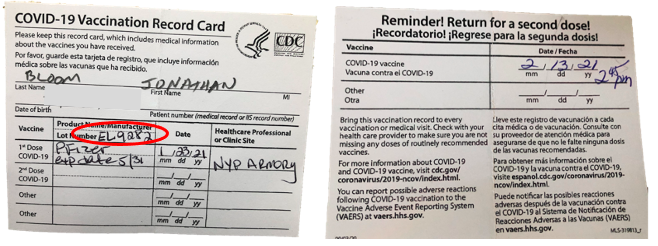
Record card. The batch number is shown in the red oval. The second appointment is on the back of the card.
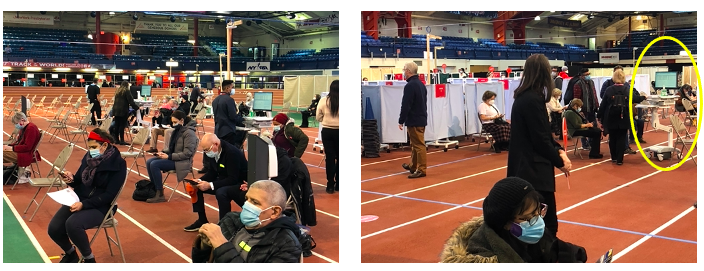
(Left) The 15-minute waiting area. (Right) A smiling scheduler (yellow oval) comes up to people who have just been injected and schedules the second dose. For exactly three weeks to the day.
The End of the Road
After your 15 minutes is up (you know this because they slap a yellow sticker on you tell you to get out at that time). Then...
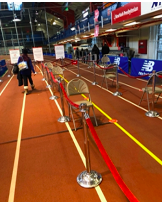
The finish line.
To Sum Up
As a New Yorker, I have been conditioned to know that nothing works right. So, it was shocking to go through this incredibly easy (and vitally important) process, especially given some of the scenes of multi-hour caravans of cars seen on TV. I have to give Weill Cornell (and whatever role New York City and State played in this) my highest praise. Job well done, folks.
As for me, I'm fine so far. Nothing out of the ordinary. Maybe a little arm soreness.

NOTE:
(1) Cornell Weill is part of the New York-Presbyterian system formed when New York Hospital merged with Columbia Presbyterian Hospital in 1998.



